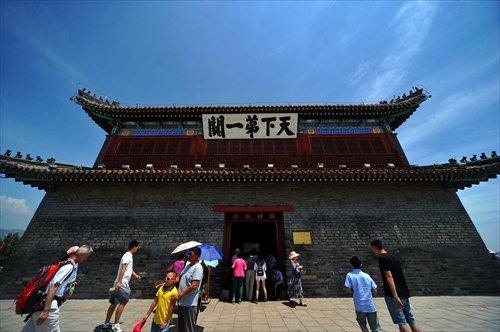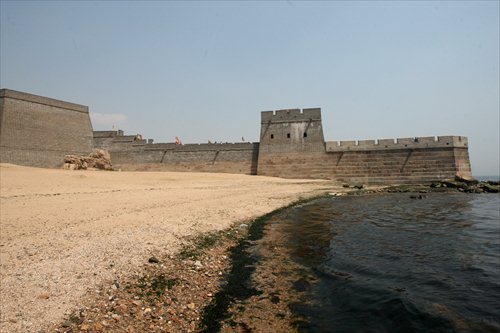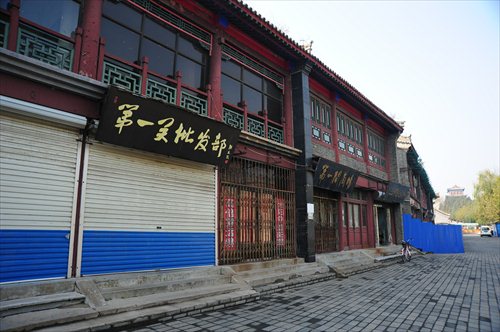The pass of mountain and sea
Walking the Shanhaiguan section of China’s Great Wall
Shanhaiguan, a well-known part of Qinhuangdao in North China's Hebei Province, made news last October when the national authority nullified the site's 5A qualification, the highest rank for a tourist destination in China. Reasons included poor sanitation, unprofessional services and rampant price fraud.
Yet, it was exactly this de-ranking, along with its importance in Chinese history, that fueled my interest to finally visit Qinhuangdao. I also assumed that, to re-attract tourists, the destination might now be in its best condition following its fall from grace. I might have overestimated.
My opportunity to travel came this past Dragon Boat Festival, during which I took a 2-hour train from Beijing to the frontier region. Shanhaiguan, which literally means "The Pass of Mountain and Sea," is one of three important passes along the Great Wall.

Shanhaiguan is one of three important passes along the Great Wall. Photos: CFP
During the Battle of Shanhaiguan in 1644, a decisive military conflict that led to the formation of the Qing Dynasty (1644-1911), former Ming (1368-1644) general Wu Sangui opened the gate to the Manchus and allied with them, allowing the latter's rapid conquer of the Ming throne in Beijing.
Originally built to defend against intrusions of Mongolian tribes, the pass now consists of a 4.8-kilometer-long wall and a barbican on the east corner, one of only four remaining barbicans, which were a vital outer defense.
My first stop was Shanhai Pass, also known as First Pass Under Heaven (40 yuan, $6.08, from May to October), which refers to a tower on the pass' major defense line, the eastern wall. I was fascinated by the rows of windows on the north and south sides of the tower, where soldiers once shot arrows at invaders.
Brief explanations along the wall show that these towers were partly destroyed during different eras of tumult, including the Japanese invasion.

The landmark Laolongtou at the very beginning of the Great Wall juts directly into the Bohai Sea.
Old dragon head
The farther you walk away from First Pass Under Heaven, the more pleasant the visit becomes, as there are fewer crowds and less engravings on the historical relic left behind by uncivilized tourists.
The landmark Laolongtou (literally Old Dragon Head) at the very beginning of the Great Wall juts directly into the Bohai Sea. Watching the waves constantly crashing and splashing against the protruding part of the dragon-shaped fortress is hypnotic.
The best vantage point is from the Guanhai (literally Watching Sea) Pavilion, hundreds of meters from Laolongtou and void of tour groups.
At Five Buddha Park (30 yuan), a section of the Great Wall zigzags over the hills, with the walkable lower part leading to a concrete barrier.
It is of course just a petty percentage of the massive Great Wall, but the sheer vertical steepness makes it quite nerve-racking and exhausting to complete.
From here, I completed my private tour of the "mountain" in Shanhaiguan, namely Jiaoshan Mountain.
I at last climbed to the top of the last section of the Great Wall, which offers a meandering view of the entire mountain range. At this point, I descended the wall and made my way into Shanhaiguan's old town, where I stayed at a traditional, North China-style four-section courtyard.

Many parts of Shanhaiguan's old town have been converted into tourist accommodations.
Touristy old town
Sadly, many parts of the old town have been converted into tourist accommodations, with the main road now mostly restaurants and shops. Some "ancient" architecture feature plaques of Chinese phrases that seem so mundane, unclassy and out of place. I'm at a loss why the local government removed the original Ming and Qing Dynasty-era plaques.
I love to eat and am usually very enthusiastic about the local cuisine of every new place I visit. However, Shanhaiguan's most authentic offering is starch that comes in blocks, usually fried or boiled in a hot pot. I had to say no thanks; I don't need any more starch in my diet.
I have no idea how bad Shanhaiguan was before the recent degradation, but, honestly, it certainly has not tried to improve itself from what I saw and experienced.
The on-site historic explanations are far from informative or well-written, numerous barbecue vendors along the path leading up to the First Pass Under Heaven disgusted me with their smoke and oil. And local taxi drivers refuse to use their meters and gleefully attempt to rip off tourist passengers.
It seems that the national authorities were justified to nullify Shanhaiguan's 5A accreditation. Nonetheless, China's Great Wall is our most cherished cultural treasure, an historical landmark recognized around the world, and deserves to be seen by everyone at least once.
With that in mind, Shanhaiguan offers important history and unique views not seen from the more-popular Beijing sections of the wall.